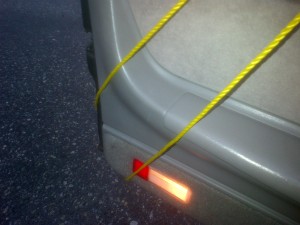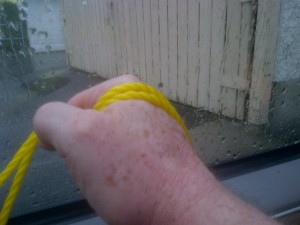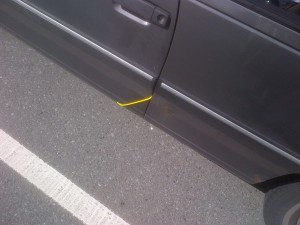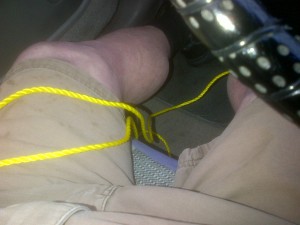A 1988 Mercury Cougar is a boat of a car; which results in doors that are large and heavy. Over time the hinge pins of the driver’s door wear to the point the door sags just enough so that the latch on the door and the latch on the car are out of alignment.
When this happens it leaves you with a door that gives out a loud ‘KlunK’ and bounces open when you try to close it.
Closing the door from the outside is relatively straight forward since you are standing which grants you the power and leverage to raise the door to align door and car latches.
The important point to know [and remember] is to engage the door lock before closing the door. The only lift point is the door handle and applying enough lift to align the latches often results in the door handle being pulled up into the open position.
Locking the door before you close it ensures that should you pull the door handle into the open position, the door opening/unlatching system is not engaged. Just as if you walked up to your locked vehicle and tried to open the door – nothing happens until you unlock the door.
Closing and locking the door from inside when seated is an entirely different kettle of fish.
Because the coupe has bucket seats and a high, wide centre console, using the passenger door for getting in and out of the driver’s seat is not a viable option.
This forces one to deal with the facts that: a) you lose the leverage advantage that standing bestows,; b) being seated limits the muscle groups you can use in closing the door; c) the outside of the car door is metal, fairly solid metal in a 1988 Cougar, while the inside is plastic and while you may find a leverage point to raise the door, after 2 or 3 times the strain will cause the plastic interior of the door to detach from the metal of the door.
Leaving you sitting there thinking “Well, Damn!”
So what do you do?
You employ the Breckenridge Emergency Ingress/Egress Method.
Employing the Breckenridge Emergency Ingress/Egress Method requires only a single piece of additional equipment – a short (approximately 10 feet) piece of rope. I use the yellow nylon rope available at any Dollar Store.
It has good crushability, important when the door closes and compresses the rope. Dollar Store rope also is cheap so that wearing it out is not an issue – you simply cut another 10 foot length of rope.
To close the door one sits in the driver’s seat and pulls the door almost closed, leaving it open about 15 cm (6 in.).
Taking the rope you fold it in half and taking the loop formed at the mid-point you reach down and hook the loop over the bottom corner of the driver’s door; making sure the two sides of the loop are 4 – 6 inches from the corner. It is important to ensure the two sides of the loop are well spaced away from the corner of the door.
If the loop is tightly hooked just on the corner it will most often slip off the corner. Should it not slip off, with the loop in that position there is insufficient leverage to raise the door enough to align the door and car latches to permit the latches to engage and fasten the door closed.
Once the loop is properly positioned on the corner of the door, you wrap the ropes running into the car around your right hand. The right hand because this positioning results in the leverage that will lift and align the door and car latches and securely latch the door closed.
You use your left hand to support the right hand.
Wrapping the rope around your left hand moves the leverage point into a position more directly above the corner of the door. This results in a reduction of leverage that results in a jarring ‘KlunK’ and the door bouncing open. On the rare occasions it does not go ‘KlunK’ the door fails to engage solidly.
When you make your first right turn the driver’s door forcefully swings open.
Newton – an object in motion wants to stay in motion. If the door is not solidly enough latched inertia brings enough force to bear on the point at which the door and car latches have partially engaged to pull the car and door latches apart.
It is only the hinge pins, those same dastardly pins that allowed the door to sag, that absorb the shock/energy generated that keeps the door attached to the car.
As opposed to the door continuing to move along t\he same line of travel dictated by the laws of motion.
When the door latches engage the rope is pinned over the corner of the door. As a result you drive down the road with a telltale line of yellow rope running across the outside corner of the door.
You need to be careful with the lengths of rope inside the car to prevent the rope becoming tangled in you legs and impairing your ability to drive. Either coil the rope ends up and tuck them down and behind the driver’s seat or run the ropes across your lap to the passenger seat.
The Breckenridge Emergency Ingress/Egress Method will minimize the problems and hassle caused by the door sagging out of alignment until one can buy some pins and find someone to install them for you or until you can save the $$$$ needed to shave a mechanic do the installation.
The door dropping does focus one on the Question of whether to Keep or Replace the vehicle?
The windows on the Cougar work at random, infrequent intervals – an inconvenienced when they don’t go down, a problem when they won’t close; only the fact the air conditioner works so well makes the Cougar usable in the summer. As you drive the Cougar around you can feel that the shock absorbers should be replaced and that the transmission needs to be treated with care to squeeze as many miles out of it before it has to be repaired/replaced. Brakes, replacement tire for the front tire that delaminated (how long will the other tires last)…………
Slowly pour $$$$$ into the Cougar or….or bite the bullet and get a new to you used car?
So I find myself letting my friends and acquaintances know I need to find a replacement for the Cougar before it dies and to keep their eyes and ears open for a ‘steal of a deal’ on a replacement automobile. A ‘steal of a deal’ because I need a dependable vehicle and I need to be able to afford to purchase it within my extremely limited budget.
I am hoping to find a dependable vehicle at an ‘extremely affordable’ price – before my……gentle reminders drive friends, acquaintances and anyone who crosses my path crazy.
A dependable, affordable vehicle so this car replacement I can replace at a time of my choosing rather than being forced to scramble and replace in haste when the Cougar dies.
Not to sound paranoid but……..what is going on with me, my car(s) and the Universe? Arrrggh.
P.S. Should you know of a vehicle, or become aware of a suitable vehicle that will grant me a respite from car woes……….please, pleASE, PLEASE do me the immense favour of bringing this automotive gem to my attention.
Please. And Thank You.




